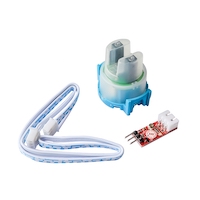Home / Shop / Products

Turbidity Sensor
Catalog: Liquid level sensors
N19,000.00
In stock
Order Summary

Your Cart is Empty
A turbidity sensor measures the clarity of a liquid by detecting the amount of light scattered by particles suspended in the liquid. It is commonly used in water quality monitoring to assess the level of contamination or the presence of particulate matter. These sensors are essential for applications in environmental monitoring, water treatment, and industrial processes.
Key Features:
Measurement Principle: Optical measurement based on light scattering Output: Analog or digital output depending on the sensor model Range: Typically measures turbidity in NTU (Nephelometric Turbidity Units) Sensitivity: Detects low to high levels of turbidity Calibration: Usually requires calibration for accurate measurements Technical Specifications:
Measurement Range: Commonly from 0 to 1000 NTU or higher, depending on the sensor Accuracy: Typically ±5% of reading or better Response Time: Generally fast, with response times ranging from a few seconds to minutes Operating Temperature: Usually from 0°C to 50°C, but varies by model Power Supply: Varies depending on the sensor; some operate on low voltage (e.g., 5V) Output Type: Analog voltage (e.g., 0-5V) or digital (e.g., I2C, UART) depending on the sensor model Housing Material: Often made of durable, chemical-resistant materials like plastic or stainless steel Connector Type: Varies, including direct wiring or connectors like JST Applications:
Water Quality Monitoring: Used to measure the clarity of water in aquariums, pools, and natural water bodies. Environmental Monitoring: Assesses turbidity in rivers, lakes, and other water sources to evaluate pollution levels. Industrial Processes: Monitors turbidity in various manufacturing processes, including beverage production and wastewater treatment. Water Treatment: Ensures the effectiveness of filtration and purification processes by measuring turbidity levels. Datasheet: Refer to the specific manufacturer’s datasheet for detailed technical information, calibration instructions, and specific operational guidelines.